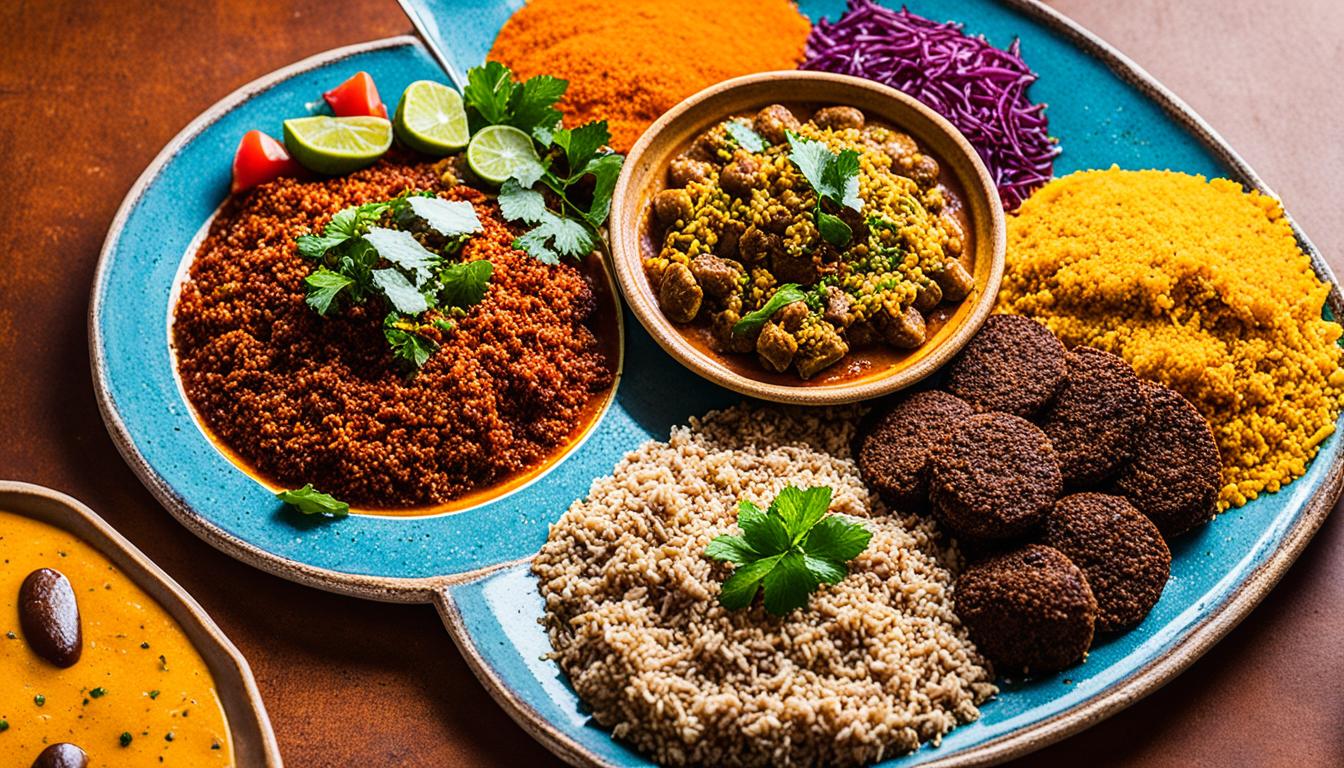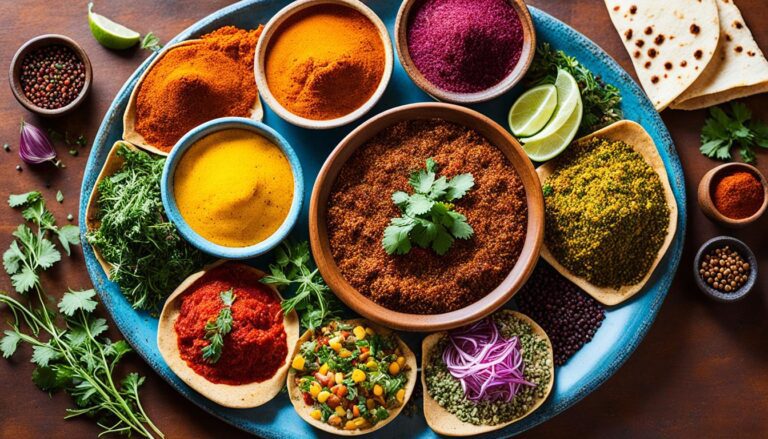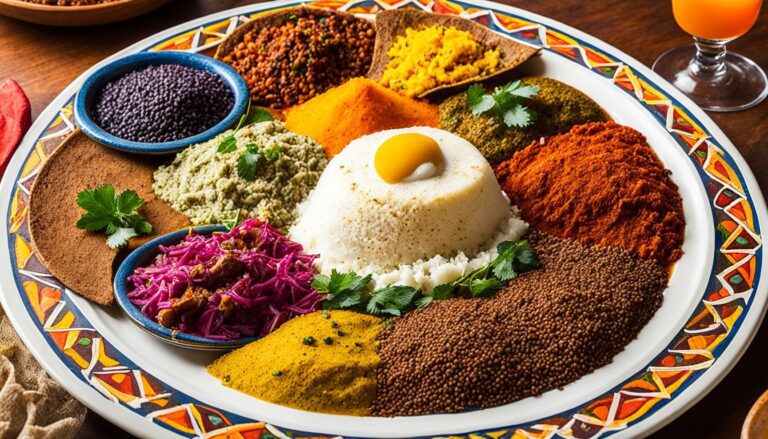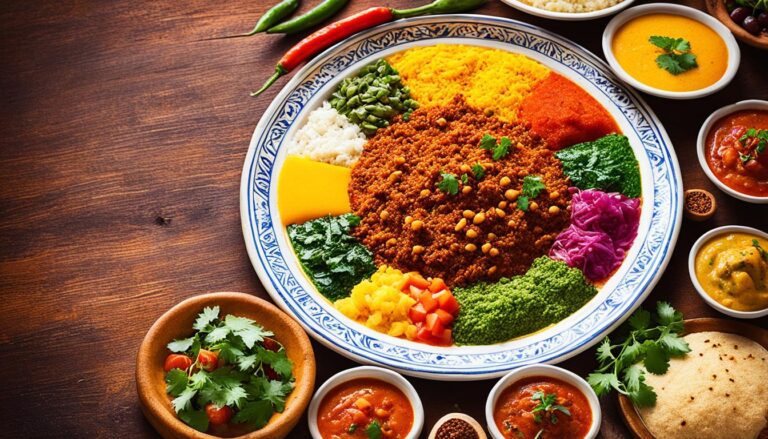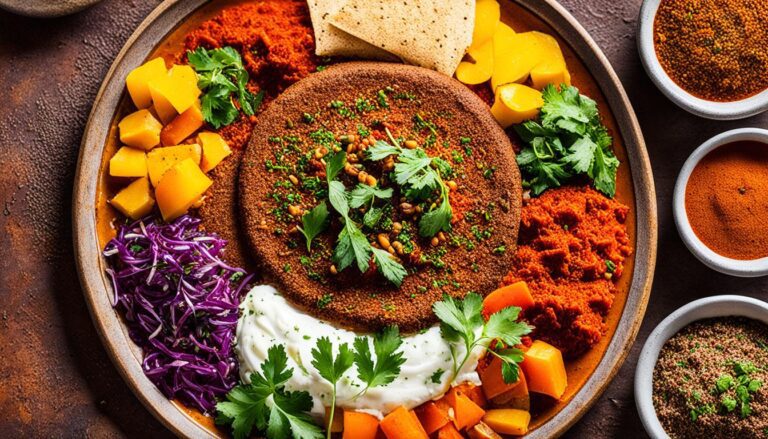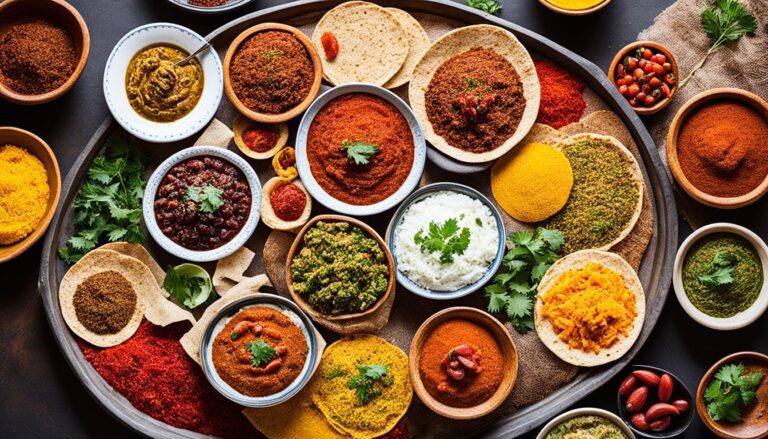What Ethiopian Food Is Not Spicy?
When we think of Ethiopian cuisine, the first thing that often comes to mind is the spicy flavors that tantalize our taste buds. But what if we told you that not all Ethiopian food is spicy? Yes, you heard that right! Contrary to popular belief, there are plenty of dishes in Ethiopian cuisine that offer a milder taste experience. So, if you’re not a fan of fiery hot spices, don’t worry – there’s something for you too!
Key Takeaways:
- Despite its reputation for spiciness, not all Ethiopian dishes are spicy.
- There are plenty of milder options available in Ethiopian cuisine.
- Vegetarian dishes, lean meat dishes, and mild spice levels are some characteristics of Ethiopian food.
- Eating Ethiopian food is a communal experience, typically enjoyed by sharing dishes on a communal platter.
- Exploring the milder side of Ethiopian cuisine can offer a delightful and enjoyable dining experience.
Introduction to Ethiopian Cuisine
Ethiopian cuisine is a delightful and flavorful experience that combines aromatic spices, tender stews, and traditional bread. When dining at an Ethiopian restaurant, understanding the menu options, making choices, and knowing how to eat can greatly enhance your culinary journey. Let us guide you through the rich world of Ethiopian food and show you how to make the most of your dining experience.
As you step into an Ethiopian restaurant, you’ll be greeted with a diverse and vibrant menu. The menu is often designed to cater to a range of tastes and dietary preferences, offering a variety of meat, vegetarian, and vegan options. From fragrant stews to aromatic spices, there are choices that will delight any palate.
When perusing the menu, you’ll find a selection of traditional Ethiopian dishes, each with its distinctive flavors and ingredients. Commonly featured dishes include doro wot, a flavorful chicken stew; kitfo, a spiced minced meat dish; and vegetarians’ favorite, Beyaynetu, a combination platter of delicious meatless options. Whether you’re a fan of bold flavors or prefer milder tastes, Ethiopian cuisine has something for everyone.
Drinks also play a significant role in Ethiopian dining culture. In addition to refreshing options like water and soft drinks, you can explore traditional Ethiopian beverages such as tej, a honey wine, and coffee, which holds a special place in Ethiopian culture. Pairing your meal with the perfect drink can elevate your dining experience and provide a deeper connection to Ethiopian culinary traditions.
Eating Ethiopian food is not just about the cuisine itself, but also about the communal and interactive dining experience. Traditional Ethiopian meals are often served on a large injera, a sourdough flatbread. Injera acts as both a plate and utensil, allowing diners to tear off pieces of bread and scoop up mouth-watering stews and sides.
So, on your next visit to an Ethiopian restaurant, immerse yourself in the flavors, textures, and communal dining traditions of Ethiopian cuisine. Explore the menu, try new dishes, savor the aromatic spices, and enjoy the unique experience of eating Ethiopian food.
Go with a Group to Sample Multiple Dishes
When dining at an Ethiopian restaurant, going with a group allows us to indulge in the rich and diverse flavors of Ethiopian cuisine. One of the best parts of eating Ethiopian food is the communal dining experience. Picture this: a large platter in the center of the table with colorful and aromatic stews, accompanied by injera, the spongy Ethiopian bread. Now imagine everyone at the table, friends and family, tearing off pieces of injera and scooping up the different dishes together. This delightful tradition not only fosters a sense of togetherness but also allows us to sample a wide variety of flavors and textures without having to order individual dishes.
By choosing group dining at an Ethiopian restaurant, we can embark on a culinary adventure, trying dishes we might not have considered on our own. Each stew and side dish offers a unique combination of ingredients and spices, showcasing the diverse range of flavors in Ethiopian cuisine. Some dishes may be milder in taste, while others might have a gentle kick of spice. Sharing these dishes allows us to appreciate the complexity of Ethiopian flavors and bond over our culinary discoveries. It’s an experience that brings people together, creating unforgettable memories.
Experiencing the Essence of Ethiopian Cuisine
Group dining in an Ethiopian restaurant provides the perfect opportunity to explore the menu and discover new favorites. Whether it’s the aromatic and hearty Doro Wat, a chicken stew seasoned with berbere spice, the rich and earthy flavor of Misir Wat, a red lentil stew, or the refreshing taste of Gomen, collard greens cooked with aromatic spices, each dish tells a story of Ethiopian culture and traditions.
Sampling multiple dishes also allows us to cater to various dietary preferences and restrictions within the group. Ethiopian cuisine offers an array of vegetarian and vegan options, such as Atakilt Wat (spiced cabbage, carrots, and potatoes), Shiro (spiced chickpea or lentil paste), and Gomen Besiga (collard greens with beef). Whether we have different taste preferences or dietary needs, there are always plenty of options to satisfy everyone’s cravings.
So, the next time you plan a gathering with friends or family, consider trying out an Ethiopian restaurant for a truly immersive dining experience. Going with a group allows us to taste the flavors of Ethiopia, sample a variety of dishes, and create lasting memories together. Don’t miss out on the unique culinary adventure that group dining in an Ethiopian restaurant offers!
Vegetarian Options for Variety
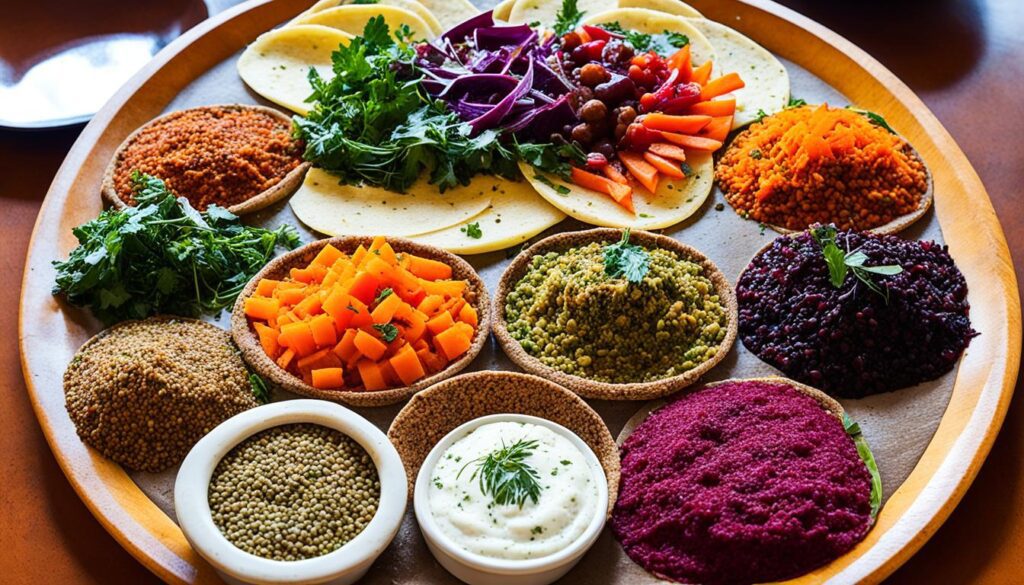
If you prefer vegetarian options or want to complement your meat dishes, the Beyaynetu, or vegetarian combination platter, is a great choice. This dish offers a variety of small portions of different vegetarian sides, providing a mix of flavors and textures.
Ethiopian vegetarian dishes are known for their unique flavors and are a must-try for any vegetarian or vegan diner.
Ethiopian Meat Dishes Are Lean
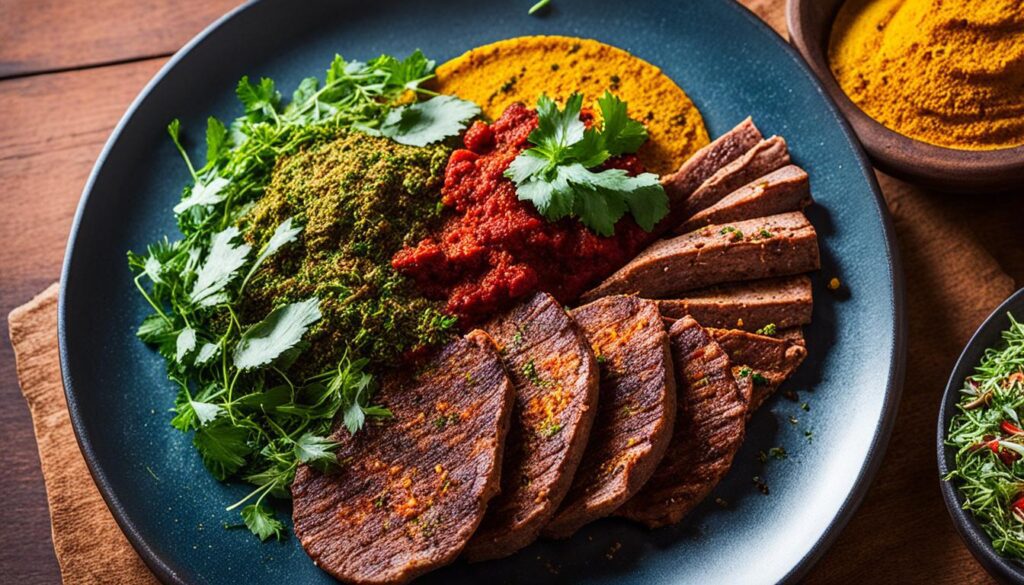
When it comes to Ethiopian cuisine, you might be surprised to learn that meat dishes, such as beef and lamb, are known for being lean and well-trimmed. This means you can enjoy the rich flavors of Ethiopian meat dishes without worrying about excessive fat content.
One popular Ethiopian meat dish that exemplifies this lean quality is doro wot, a delicious chicken stew. Doro wot is made with chicken drumsticks or thighs that are carefully trimmed of excess fat, ensuring a lean and flavorful dish.
However, it’s important to note that while Ethiopian meat dishes are generally lean, the cuisine as a whole is not low in fat. This is because Ethiopian meat dishes are often prepared with niter kibe, a spiced clarified butter, for added depth of flavor. Additionally, vegetable dishes are typically cooked in oil, further contributing to the overall richness of Ethiopian cuisine.
So, while Ethiopian meat dishes offer lean options for meat lovers, it’s always good to be mindful of the overall fat content and enjoy Ethiopian cuisine in moderation.
Spice Levels in Ethiopian Cuisine
Contrary to popular belief, Ethiopian cuisine is not excessively spicy. While some dishes may contain berbere, a red pepper spice blend, it is not overly fiery hot. Ethiopian spice levels can be described as spiced but not spicy. If you’re unsure about the level of spice in a dish, you can always ask your server for a sample to gauge your tolerance. Dishes labeled as “wot” typically contain berbere, while those labeled as “alicha” are milder and lack the spiciness.
When it comes to Ethiopian cuisine, the perception of spiciness can sometimes overshadow the rich and diverse flavors it offers. While there are indeed spicy dishes to be found, it’s important to remember that not all Ethiopian food will set your taste buds on fire. The use of spices in Ethiopian cooking is more about enhancing the flavor profile rather than overpowering with heat.
Berbere, a staple spice blend in Ethiopian cuisine, is a complex mixture of spices that gives dishes a unique and robust flavor. It consists of ingredients like chili peppers, garlic, ginger, fenugreek, and various aromatic herbs. While berbere does add a certain level of spiciness, it is balanced by other flavors, making Ethiopian dishes more well-rounded and enjoyable.
It’s worth noting that there are also plenty of Ethiopian dishes that are not spicy at all. For those who prefer milder flavors, dishes labeled as “alicha” are a great choice. These dishes typically do not contain berbere and offer a more subtle and gentle taste experience. From vegetable stews to lentil curries, there are plenty of non-spicy options to explore.
When ordering at an Ethiopian restaurant, don’t be afraid to ask about the spice level of a specific dish. The staff will be more than happy to assist you in choosing something that suits your taste preferences. In fact, many restaurants are accustomed to serving customers with varying spice tolerances and will gladly accommodate your request.
So, if you’re looking to enjoy the flavors of Ethiopian cuisine without the overwhelming spiciness, don’t hesitate to explore the diverse range of options available. From the spiced dishes labeled as “wot” to the milder “alicha” dishes, there is something for everyone to enjoy.
Eating Etiquette and Injera
When it comes to traditional Ethiopian dining, there’s an art to eating with your hands. Ethiopian cuisine is renowned for its unique bread called injera, which plays a central role in the dining experience.
Injera is a fermented bread that serves as both a utensil and a staple food. To enjoy your meal, tear off a piece of injera with your right hand and use it to scoop up the stews and dishes from the communal platter. In Ethiopian culture, using your left hand is considered impolite, so be sure to use your right hand when engaging in this culinary tradition.
In American restaurants, it is common to use both hands for tearing off injera. This allows for easier handling and a more comfortable dining experience.
Injera should be moist and have a spongy texture. It is typically served at room temperature or slightly warmed. The main ingredient in injera is teff flour, a gluten-free grain native to Ethiopia. However, most Ethiopian restaurants outside of Ethiopia use a mix of flours, including wheat and barley, to make injera.
Eating with injera not only adds a unique tactile element to the meal but also enhances the flavors of the dishes. The slightly tangy and earthy taste of injera complements the rich and aromatic stews and spices found in Ethiopian cuisine.
So, the next time you visit an Ethiopian restaurant, embrace the cultural experience and enjoy the delightful combination of eating with your hands and savoring the delicious flavors of injera and the diverse Ethiopian dishes.
Conclusion
Ethiopian cuisine offers a tantalizing journey of flavors and diverse options for a truly enjoyable dining experience. While many people associate Ethiopian food with spicy dishes, there is so much more to explore. From the rich vegetarian options to the lean and flavorful meat dishes, Ethiopian cuisine caters to a wide range of palates.
Whether you’re a newcomer to Ethiopian food or a seasoned aficionado, exploring the milder side of Ethiopian cuisine can be a delightful adventure. The combination of aromatic spices and complex flavors creates a culinary experience that is both inviting and satisfying.
So next time you step into an Ethiopian restaurant, don’t be afraid to venture beyond the fiery spices. Embrace the mild flavors, savor the diverse options, and immerse yourself in the cultural richness of Ethiopian cuisine. You may just find yourself uncovering new favorites and creating unforgettable memories with each bite.

